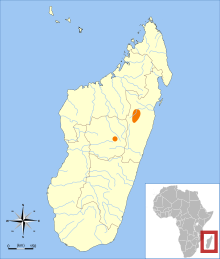Alaotra grebe
You can help expand this article with text translated from the corresponding article in French. (November 2021) Click [show] for important translation instructions.
|
| Alaotra grebe | |
|---|---|

| |
| Scientific classification | |
| Domain: | Eukaryota |
| Kingdom: | Animalia |
| Phylum: | Chordata |
| Class: | Aves |
| Order: | Podicipediformes |
| Family: | Podicipedidae |
| Genus: | Tachybaptus |
| Species: | †T. rufolavatus
|
| Binomial name | |
| †Tachybaptus rufolavatus (
Delacour , 1932) | |

| |
| Alaotra grebe range | |
The Alaotra grebe (Tachybaptus rufolavatus), also known as Delacour's little grebe or rusty grebe, is a recently extinct grebe that was endemic to Lake Alaotra and its surrounding lakes in Madagascar. Experts say that the grebe became extinct after carnivorous fish were introduced into its native habitat.
Description
The grebe was about 25 cm (9.8 in) long.[2] Its ability to fly long distances was restricted because of its small wings.[3] It exhibited no marked sexual dimorphism, although males were slightly larger than females.[4]
Diet
The Alaotra grebe fed mostly on fish, although insects were found in the stomachs of a few specimens.[5] Its hefty bill was considered typical of a piscivorous grebe.[5]
Breeding
The breeding behavior of the Alaotra grebe was largely undocumented. Because
Extinction
The species declined in the course of the 20th century, mainly because of habitat destruction, entanglement with monofilament gillnets and predation by the introduced blotched snakehead (Channa maculata).[6] Also, the few remaining birds increasingly hybridized with little grebes; as the species differed in several key aspects, the hybrid birds may have suffered from decreased fitness, to the detriment of the rufolavatus gene pool.[7][8]
The Madagascar pochard, which also lived on Lake Alaotra, was thought to be extinct but was rediscovered in 2006.[9] Unlike this species, however, the grebe had poor powers of dispersal and was never found elsewhere.[8]
The last sighting (which may have been a hybrid with the
This extinction brought the number of confirmed bird extinctions since 1600
Distribution and habitat
"This aquatic species exhibited endemism to the island of Madagascar, exclusively inhabiting the environs of Lake Alaotra and adjacent water bodies. Notably, this grebe displayed a marked preference for the reed beds and papyrus clusters in the vicinity of the lake, which served as its primary nesting habitat."[13]
Gallery
-
An artist's reconstruction.
See also
- Atitlán grebe, extinct since 1989 for similar reasons
- Endemic birds of Madagascar and western Indian Ocean islands
References
- . Retrieved 19 November 2021.
- ISBN 978-0-7614-7194-3.
- ^ a b c d Walker, Matt (26 May 2010). "Bird conservation: Alaotra grebe confirmed extinct". BBC News. Retrieved 26 May 2010.
- ISSN 0030-6525. Archived from the original(PDF) on 2012-04-19. Retrieved 2023-02-19.
- ^ a b c d e Safford 2013, p. 111
- S2CID 1063617.
- ^ Madagascar: Environment Profile
- ^ ISBN 978-1-4081-7215-5.
- ^ "Madagascar's Rediscovery" (PDF). BirdLife International. October 2006.
- ^ BirdLife International (2010) Species factsheet: Tachybaptus rufolavatus. Downloaded from "BirdLife | Partnership for nature and people". Archived from the original on 2007-07-10. Retrieved 2013-08-07. on 26 May 2010
- ^ a b BirdLife International (2010). Wetland aliens cause bird extinction.
- ^ a b Elliott, Valerie (26 May 2010). "Alaotra grebe declared extinct after struggle against carnivorous fish". The Times. Retrieved 26 May 2010.
- ^ "redlist assesment about the bird".
Cited texts
- Safford, Roger (2013), "Alaotra Grebe Tachybaptus rufolavatus", in Safford, Roger; Hawkins, Frank (eds.), The Birds of Africa, vol. VIII: The Malagasy Region, London: Christopher Helm, pp. 110–111


